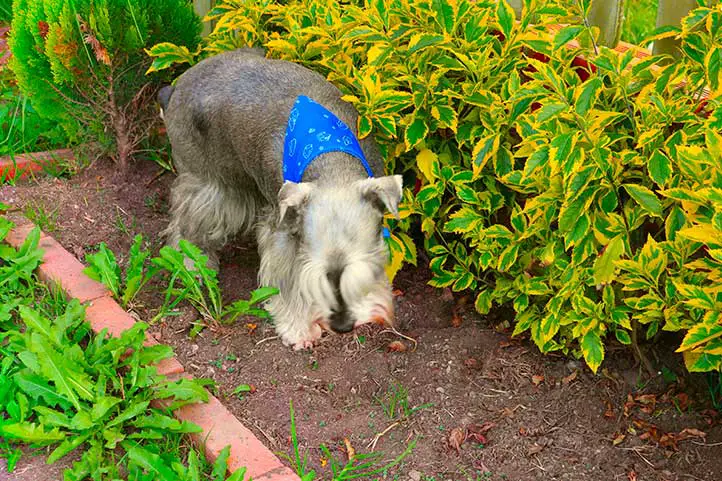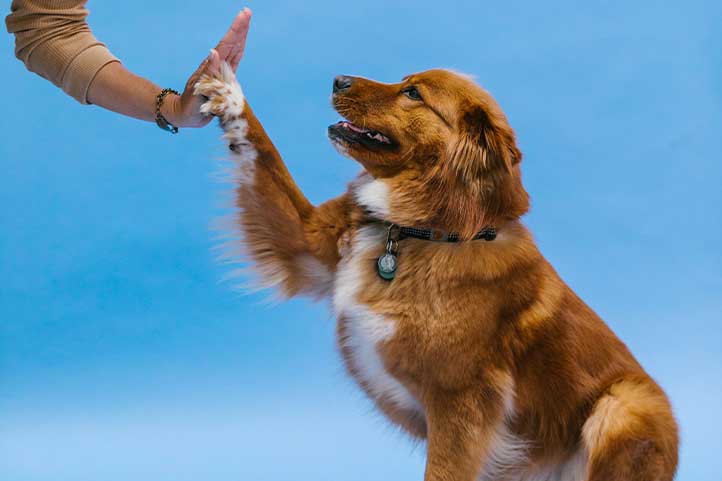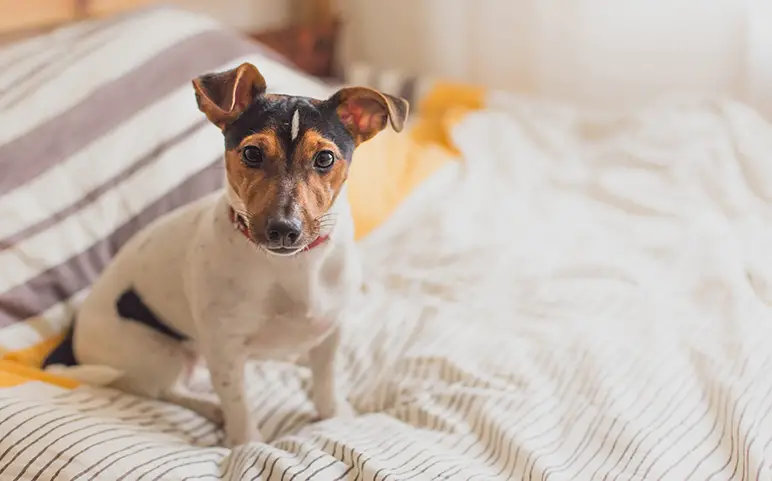Translated by Nick R
If your dog does its business indoors, don’t panic! Just like us, they were not born learned.
Many reasons can cause a dog to relieve itself at home: lack of teaching, stress, and physical or psychological problems. You must be patient with your dog, and train it with love and respect.
Therefore, I’ll explain what you must take into account to teach your pet to go to the bathroom outside the house. Here are 6 tips to succeed.
Table of Contents
3 points to consider
First of all, there are three aspects you should consider before you start toilet training your puppy.
Puppies
If your furry one is still a puppy you should keep these two things in mind:
- Bladder control: it’s natural that your puppy doesn’t know how to control its bladder and needs to go to the bathroom several times a day. Don’t scold or get mad at it, as it gets older it will learn to control it.
- Vaccinations: also, remember that for the first few months you shouldn’t take your puppy outside; it must first have all of its vaccinations or it could get sick or get infections. After getting the third vaccination, you can start walking your puppy outside.
NOTE: Vaccinations will protect them against distemper, parvovirus, and rabies. Our pet’s vaccination plan begins at 45 days of age, between 45 and 65 days it will receive vaccines against parvovirus, distemper, pentavalent + coronavirus vaccine, and rabies vaccine.
Adult dogs
If your dog is an adult you should keep these 3 things in mind:
- Aging: It is natural that, if your dog is already old, he/she suffers from urinary incontinence. As they get older, their muscles weaken and the control they have over parts of their body, such as their bladder, decreases.
This situation will be as frustrating for them as it is for you. Take them to the veterinarian to find the solution that best suits your pet.
- Lack of education: Maybe your pet is already an adult and has never been taught where to go to the bathroom, you must be patient, it may be a little more difficult to get it out of habits it has had for a long time, but not impossible.
- Behavioral changes: On the other hand, if your dog is already trained and suddenly starts to relieve himself in inappropriate places, it may be due to a urinary disease or a problem that has caused a change in his behavior.
Diseases and behavioral problems
If your pet suddenly changes the places and times in which it is used to relieve itself, it may be due to different reasons.
I’ll explain what may be affecting your furry one and how to identify it.
Marking territory
This is an instinctive behavior by which the dog makes it clear to other dogs what his territory is. It is more common in males, although it can occur in females before or during the heat.
It can also be that your pet is too dominant and the coexistence with other animals can generate this behavior.
This will depend on your canine’s personality, but some breeds are more predisposed to be dominant, such as the Cocker Spaniel, the Rottweiler, the Pekingese, and the Chihuahua.
The best way to avoid this situation is to have them spayed or neutered. This will reduce or completely eliminate the problem. It is best to have it done at an early age before your dog gets too used to this behavior.
Stress and anxiety
If your dog is not used to spending too much time alone at home, it will probably do inappropriate things when alone, such as chewing on couches, tearing up furniture or clothes, and even urinating or pooping indoors.
This is called “separation anxiety”, and you better get your pet used to being alone, so you can take him out for a walk every day half an hour or an hour before you leave the house to reduce stress and hyperactivity.
I recommend you to read our tips to reduce stress and anxiety in your dog and how to distract your dog while you are away from home.
Urinary tract problems
This type of problem is more common in adult dogs, older than 7 years old, and can be caused by bladder stones or bacterial infections.
This is important to be aware of and take your dog to the veterinarian for proper treatment. Some symptoms you should be aware of are:
- Blood in the urine of your pet.
- Difficulty urinating or urinating less than before.
- Incontinence: no bladder control and urinating in unusual places.
- Painful urination: whining or whimpering during urination.
If you want to know more about this topic you can read this research on Diseases of the caudal urinary tract in dogs.
7 tips for teaching your dog to relieve itself outside home
After you have discarded any behavioral problems or urinary disease, use the following tips to teach your dog to relieve himself outside the house.
1. Cleaning up
Don’t scrub the floor when your dog goes indoors, as you’ll only spread the odor, causing your pet to want to continue doing it there.
Dry the floor with absorbent paper towels and then clean with an odor-eliminating product. Do not use products with a strong odor such as ammonia or vinegar because your furry one will go back to relieve himself in the same place to cover up a smell it does not like.
One day my aunt’s dog pooped on the stairs, which are covered with carpet and are difficult to clean up. To disguise it, so my aunt wouldn’t notice, my cousins quickly cleaned up as best they could.
Yet, the puppy went back in there the next day. If there are urine or poop smells left, the dog will be motivated to do it again, that’s their instinctive behavior. For this reason, cleaning very well is essential.
Enzymatic cleaners are recommended. They are easy to find as they have several uses. Apart from cleaning animal urine, they are used in sanitary enclosures, in septic tanks, and in the food industry to eliminate odors and stains.
2. Don’t scold your pet
Dogs won’t know what they’re doing wrong unless we teach them, we must be patient and train them to understand where they should do their needs.
The moment your dog does his business at home you can tell it “no” just once by pointing at the place; then just leave it alone and clean the area very well.
It is useless to scold it all day long, dogs live in the present, you can draw their attention at the moment it did something wrong but later it will be useless because it won’t understand why you are scolding it.
Remember that the best way to teach is by giving positive reinforcement, not by scolding or instilling fear.
3. Identify your dog’s behavior
I’m sure you’ve noticed that whenever your dog is about to pee or poop, it starts sniffing and circling around the house.
This will be your signal, I taught my dog to do its needs outside just after she had all the vaccinations. When noticing she had the intention to relieve itself inside, I would take it quickly to the street and prize it once it finished.
This is how Amber, my puppy, learned, and now she never does her business indoors.
Remember a puppy needs to go potty more often. If your dog is older, you can calculate how long it takes before it needs to go to the bathroom and start creating a schedule for it.
Trainers say there are 3 times when you should take your dog out to relieve himself:
After your dog wakes up
After waking up, it’s normal for your dog to feel like going to the bathroom, so as soon as he wakes up, either in the morning or after a long nap in the afternoon, take it for a walk.
A few minutes after eating
After eating and drinking water your dog will be ready to relieve himself. You can take it out immediately, although I recommend letting it sit for a few minutes to avoid gastric torsion, especially if it is a large breed dog.
NOTE: Gastric torsion is a serious disease that must be treated urgently, it is a torsion of the stomach caused by excess gas or air. It may happen when your dog eats and drinks too fast or if he exercises right after eating, so it is best to wait for him to eat and rest before playing or going for a walk.
After playing
After playing for a while your dog will be relaxed and will concentrate on doing his business.
If you have a playing routine with your dog, take it for a walk when you’re done.
4. Treats or petting
As I told you before, after identifying your dog’s behavior when it goes to the bathroom, take it out quickly and congratulate it when it does it in the street.
It is not necessary to feed it a snack, just let it know it did something well; you can reward it with caresses too.
The best way to teach is with positive reinforcement.
5. Walk your dog
At the beginning of the training, you need to take it out multiple times a day so that there are more opportunities for it to relieve itself outside.
A puppy would require at least 5 to 6 outings a day, while an adult dog with better bladder control will need about 3 outings.
The amount of time depends on your dog. Large breed dogs will need 1 to 1.5 hours of activity. For small or medium breeds, a half hour to 1 hour will be fine.
Here is a list of some breeds according to their size.
Small dog breeds
- Chihuahua
- Shih Tzu
- Yorkshire Terrier
- Pomeranian
- Pekingese
Medium-size dog breeds
- English Cocker Spaniel
- Beagle
- Poodle
- Schnauzer
Large dog breeds
- Saint Bernard
- German Shepherd
- Rottweiler
- Golden Retriever
- Siberian Husky
- Great Dane
- Dalmatian
- Doberman
- Bernese Mountain Dog
If you want to know more you can read the article 20 dog breeds that require more exercise due to their anatomy.
6. Routine of your dog
A routine will provide stability and confidence to your dog, and it will even prevent stress or anxiety for your pet, since it will know when you are coming home, when you are feeding it and when it is time for walks.
Keep in mind what I have explained above to create the right routine for you and your pet.
For example, my dog, Amber, we take her out three times a day, at 7-8 am when she wakes up, at 2:30 – 3 pm and at 8 pm right after her last meal.
Create your schedule
I will help you create your schedule. Think about what time you normally get up and what time you leave the house for work or school.
You could take your pet out when you get up, but it’s best to do it right before you leave so it won’t have to wait as many hours.
Next, be sure to take him out in the middle of the day. If you are too busy or can’t go home, make sure someone helps you with that. Holding its needs for a long time is not good for your dog’s health.
And finally, walk him at night before going to bed or if you get home very late, take your dog out as soon as you arrive.
| Schedule for taking your dog out |
| In the morning – 6 am to 7 am If you wake up early to go to work or study, feed your dog immediately so it can digest the food while you get ready to go out. Once you’re ready, take it outside to relieve itself. |
| In the afternoon – 12 am to 2 pm It will depend on how early you took your dog out in the morning, the less hour it waits the better. If you can’t take it out yourself, ask a friend, relative, or neighbor. You can also hire a dog walker. |
| At night – 8 pm to 9 Before going to bed, take your dog out. It will also depend on how many hours ago it was taken out. |
| Careful! This schedule works for adult dogs that know to control themselves. A puppy will need more outings a day. |
7. Teach your puppy to relieve itself on a newspaper or soaker.
In case your puppy is not fully vaccinated yet, and therefore you can’t take it outside to relieve itself, teach it to do it on a soaker or newspaper. This way you’ll avoid this behavior in places you don’t want it to be.
This will also help if you don’t have enough time to take him out for a walk several times a day and he won’t hold his needs for long.
The method is the same as the one for teaching dogs to relieve themselves outside; as soon as you see your puppy sniffing and wandering around, pick it up and take it to the newspaper.
He may try to get out of the newspaper or soaker, so block his way until he has no choice but to relieve himself there.
Also, keep in mind that since your puppy is just learning, you should restrict his access to the entire house. This means that you should close the doors of the rooms and you may have to put boards or things that block the access to the kitchen and the living room.
This will limit the places where your dog will go to the bathroom, and make it more likely that it uses the newspaper.
NOTE: Don’t put the newspaper or soaker near the dog’s bed, dogs don’t like to relieve themselves where they sleep.
Recommendation
If you don’t have much time to take your dog out as often as it needs, you can ask your relatives for help or pay a dog walker. This way your dog won’t have to stand for a long time and will also do physical activity, which is very important for a good quality of life.


